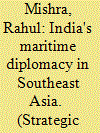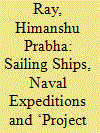| Srl | Item |
| 1 |
ID:
123301


|
|
|
|
|
| Publication |
2013.
|
| Summary/Abstract |
INS Sudarshini, India's Sail Training Ship (STS), was sent on a commemorative expedition to the Association of South East Asian Nations (ASEAN) member countries for six months along the monsoon trade winds route to trace India's civilisational and cultural affinities and rejuvenate trade and maritime linkages with its neighbours in the East. The voyage was part of the commemoration of the successful completion of two decades of India's Look East Policy, 20 years of dialogue relations with ASEAN, and 10 years of India-ASEAN summit-level partnership. The expedition, a collaborative venture of India's Ministries of Defence and External Affairs, traced sea routes developed centuries ago, linking India with countries of the Southeast Asian region. The heartening reception of the INS Sudarshini expedition across the Southeast Asian region has underscored the point that India's maritime diplomacy has been a success in the region. The expedition also highlights the point that since India and Southeast Asia are immediate neighbours, there is a need to work towards ensuring greater connectivity between India and the countries of the region. As part of the commemoration, an India-ASEAN car rally was also organised, covering about 8,000 km and nine out of 10 ASEAN states. It is worth mentioning that India shares a land boundary with Myanmar and a maritime boundary with three Southeast Asian nations. The success of the INS Sudarshini expedition (and the India-ASEAN car rally) clearly indicates that compared to the situation during the 1980s and early 1990s, a substantive perceptual change has come about in the Southeast Asian approach towards India.
|
|
|
|
|
|
|
|
|
|
|
|
|
|
|
|
| 2 |
ID:
174939


|
|
|
|
|
| Summary/Abstract |
In recent years, sailing ships of the Indian Navy have been increasingly involved in diplomatic missions and cultural voyages across the world, in addition to their primary purpose of providing practical training in navigation techniques and seamanship. These three-masted barques built at the Goa Shipyard and used by the Indian Navy are very different from wooden sailing vessels that traversed the Indian Ocean in the premodern period prior to the development of steamship navigation in the nineteenth century. Nonetheless, these distinctions have often been blurred as these modern naval ships have been utilised to recreate historical ‘expeditions’ such as the much-celebrated Chola invasion of Srivijaya in the Indonesian archipelago. Nor is India the only country to be involved in promoting this ‘popular history’ for contemporary geopolitical interests, as is evident from China’s efforts to rebuild ships used in the Voyages of Admiral Zheng He across the Indian Ocean. What gets short shrift in the process is investment in research in underwater archaeology and the discovery and preservation of shipwreck sites. This article highlights the urgent need for interdisciplinary research in premodern shipping and seafaring activity beyond the rhetoric of valorising national heroes.
|
|
|
|
|
|
|
|
|
|
|
|
|
|
|
|